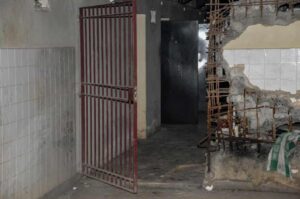
The 56 days that Patrick Onyango spent in Kenya’s dark, damp Nyayo House torture chambers remain clear in his mind. It was three deacdes ago that Onyango, now 66, knew that his opposition to the autocratic rule of Kenya’s second president, Daniel arap Moi, was to be punished when uniformed policemen seized him in the middle of a class he was teaching in Kisumu, the port city in western Kenya, bundling him on to a helicopter and whisking him to the capital, Nairobi.
There he was shuttled from one prison cell to another for nearly a week, he says, before being blindfolded and taken through a narrow tunnel to the cells of the infamous Nyayo torture chambers.
Onyango was made to undress, and then beaten and stabbed. Denied food and water in his cell for nearly two weeks, he drank his own urine to survive.
“I was subjected to all kinds of torture – it was very cruel, very inhumane,” says Onyango, who angered the Moi regime for his student activism against one-party rule in the early 1980s.
Moi, Kenya’s longest-serving president, had seen off a coup attempt by a section of the armed forces in 1982. Afterwards he cracked down hard, introducing excessive policing and human rights abuses and passing laws to suppress political freedom.
During the height of the crackdown between 1986 and 1992, more than 150 pro-democracy activists were detained and tortured in the Nyayo cells.
Every February since, Onyango and other survivors have returned to visit the cells in an act of remembrance with members of the public who want to know more about the atrocities.
This dark chapter of Kenya’s history is barely taught in schools and the old interrogation cells in the basement of a multi-storey immigration centre are classified as a “protected area” that can only be accessed with permission from the security services and Nairobi officials.
